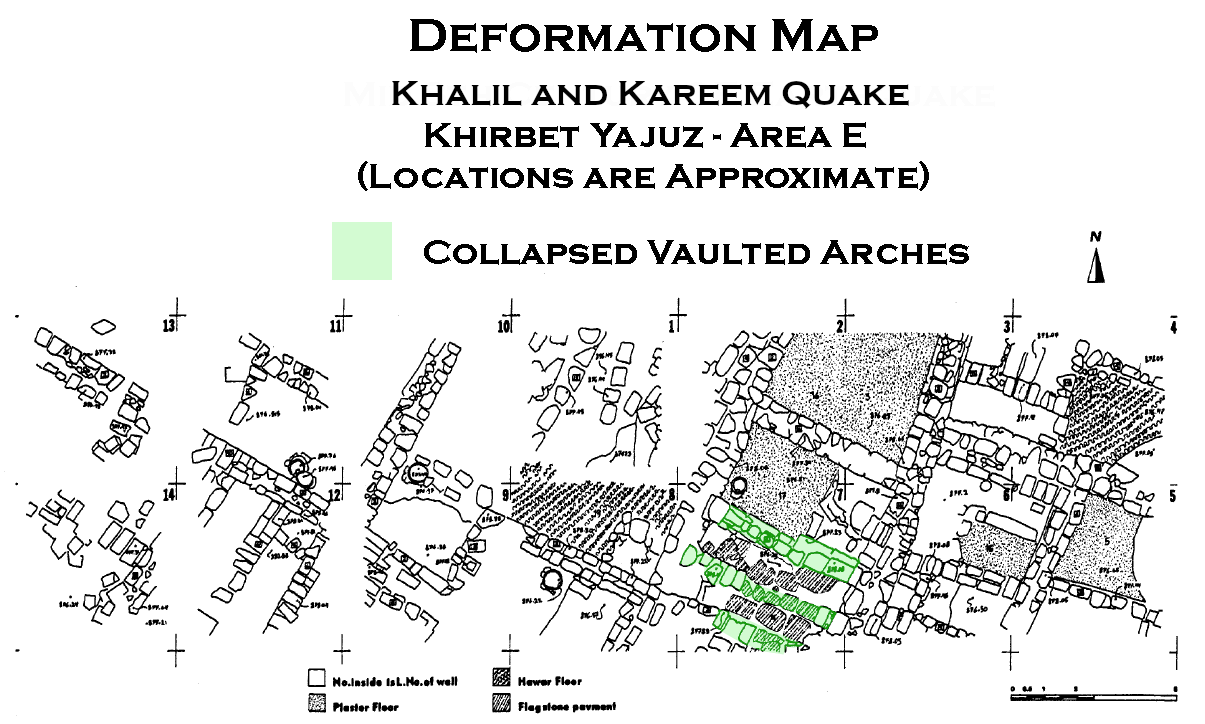Khirbet Yajuz
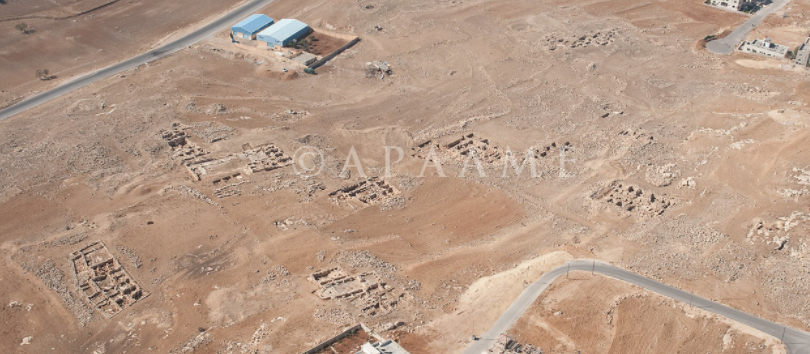 Aerial Photograph of Khirbet Yajuz
Aerial Photograph of Khirbet YajuzAPAAME CC BY-NC-ND 2.0
| Transliterated Name | Language | Name |
|---|---|---|
| Khirbet Yajuz | Arabic | كهيربيت ياجوز |
| Khirbet Mudraj | Arabic | كهيربيت مودراج |
| Talat Nimr | Arabic | تالات نيمر |
Khirbet Yajuz is an archeological site ~11 km. NE of Amman, Jordan. It contains the remains of a village that was occupied from the Roman to Ayyubid/Mamluk period. Excavations at the site revealed numerous seismic effects which appears to be tightly dated to the mid 8th century CE.
- Aerial View of Khirbet Yajuz
from APAAME

 Aerial View of Khirbet Yajuz
Aerial View of Khirbet Yajuz
APAAME - Khirbet Yajuz in Google Earth
- Fig. 1 - Site map from
Khalil and Kareem (2002)
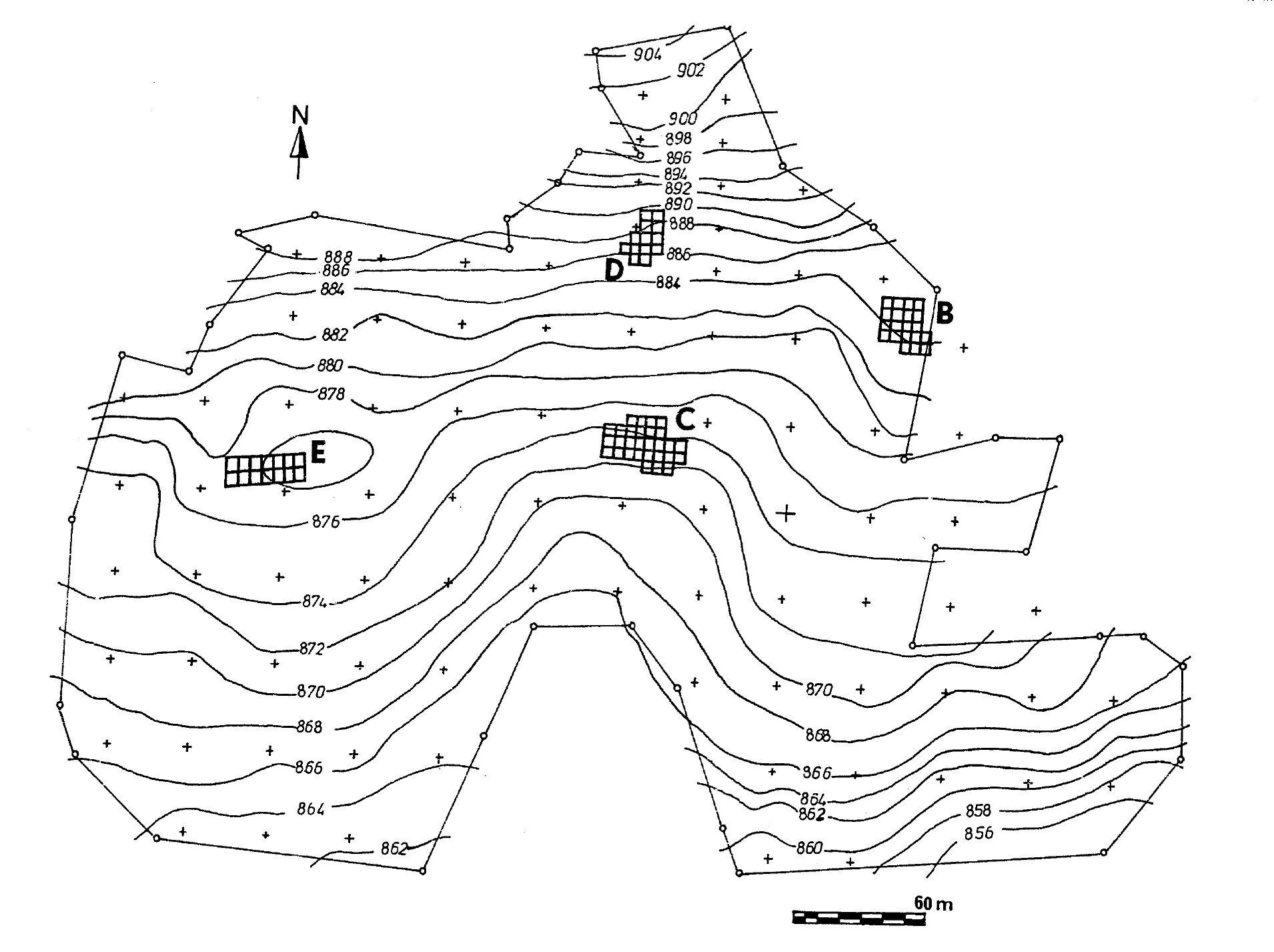
 Figure 1.
Figure 1.
Contour map of Khirbat Yajuz, showing the location of excavations (Areas: B, C, D and E).
Khalil and Kareem (2002)
- Fig. 1 - Site map from
Khalil and Kareem (2002)

 Figure 1.
Figure 1.
Contour map of Khirbat Yajuz, showing the location of excavations (Areas: B, C, D and E).
Khalil and Kareem (2002)
- Fig. 2 - Area E plan
from Khalil and Kareem (2002)
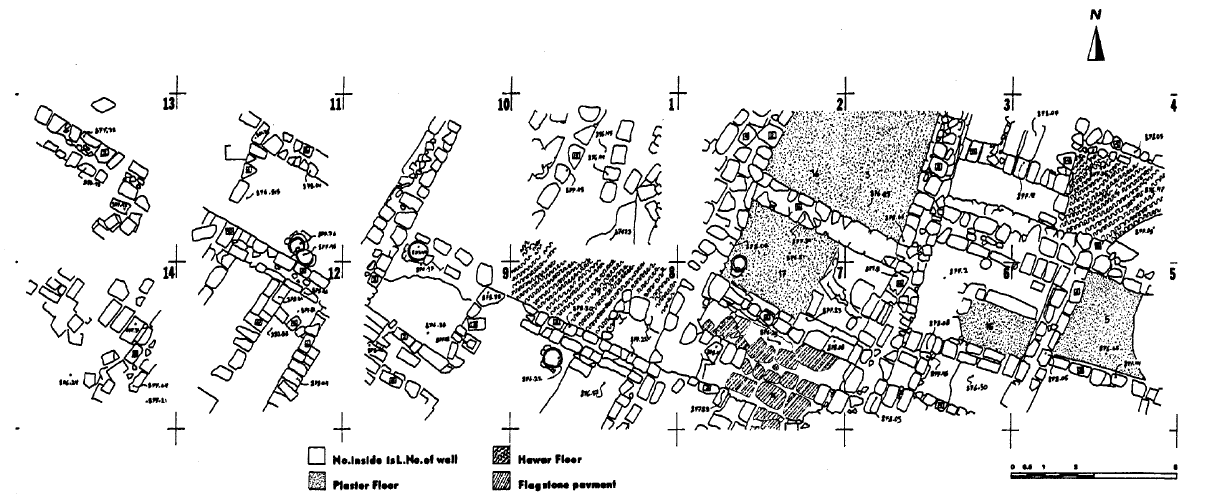
 Figure 2
Figure 2
Khirbat Yajuz, Area E: plan of the architeetural features in squares 1-14.
Khalil and Kareem (2002) - Fig. 3 - Area E, east
section of square 7 from Khalil and Kareem (2002)

 Figure 3
Figure 3
Khirbat Yajuz, Area E, east section of square 7
Khalil and Kareem (2002) - Fig. 4 - isometric
reconstruction of Umayyad structures in squares 2, 6, 7. and 8 of Area E from Khalil and Kareem (2002)

 Figure 4
Figure 4
Khirbat Yajuz, Area E; isometric reconstruction of Umayyad structures in squares 2, 6, 7. and 8
Khalil and Kareem (2002) - Fig. 6 - isometric
reconstruction of Abbasid structures in squares 2, 6, 7. and 8 of Area E from Khalil and Kareem (2002)

 Figure 6
Figure 6
Khirbat Yajuz, Area E; isometric reconstruction of Abbasid structures in squares 2, 6, 7. and 8
Khalil and Kareem (2002)
- Fig. 2 - Area E plan
from Khalil and Kareem (2002)

 Figure 2
Figure 2
Khirbat Yajuz, Area E: plan of the architeetural features in squares 1-14.
Khalil and Kareem (2002) - Fig. 3 - Area E, east
section of square 7 from Khalil and Kareem (2002)

 Figure 3
Figure 3
Khirbat Yajuz, Area E, east section of square 7
Khalil and Kareem (2002) - Fig. 4 - isometric
reconstruction of Umayyad structures in squares 2, 6, 7. and 8 of Area E from Khalil and Kareem (2002)

 Figure 4
Figure 4
Khirbat Yajuz, Area E; isometric reconstruction of Umayyad structures in squares 2, 6, 7. and 8
Khalil and Kareem (2002) - Fig. 6 - isometric
reconstruction of Abbasid structures in squares 2, 6, 7. and 8 of Area E from Khalil and Kareem (2002)

 Figure 6
Figure 6
Khirbat Yajuz, Area E; isometric reconstruction of Abbasid structures in squares 2, 6, 7. and 8
Khalil and Kareem (2002)
- Fig. 15 - Collapsed Arch from
Khalil (1998)
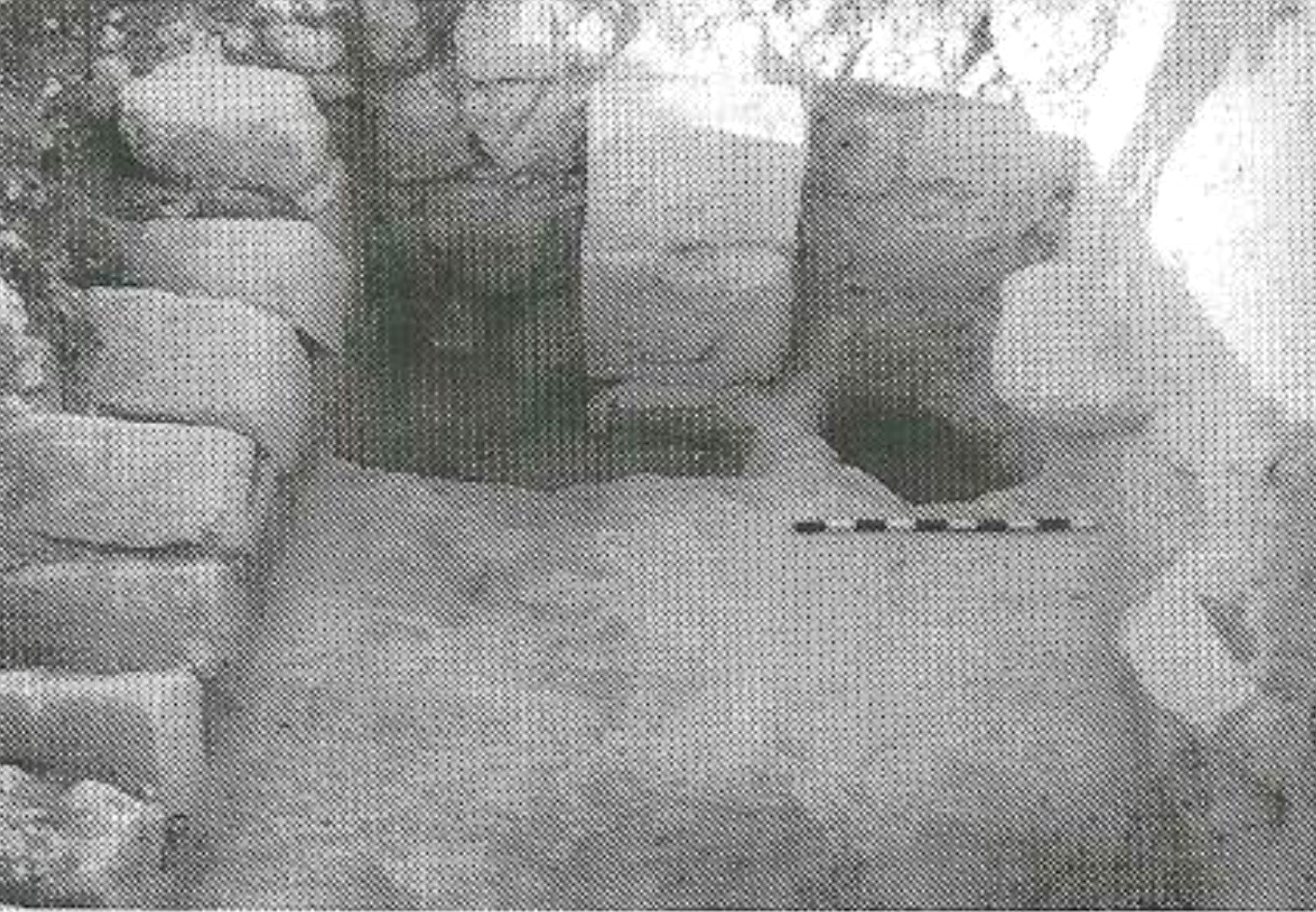
 15
15
Collapsed arch above plaster floor, looking south.
Khalil (1998) - Fig. 22 - Paved Room from
Savage et al (2001)

 Figure 22
Figure 22
Paved room at Khirbet Yajuz.
Savage et al (2001) - Fig. 25 - Early Abbasid finds from
Khalil and Kareem (2002)
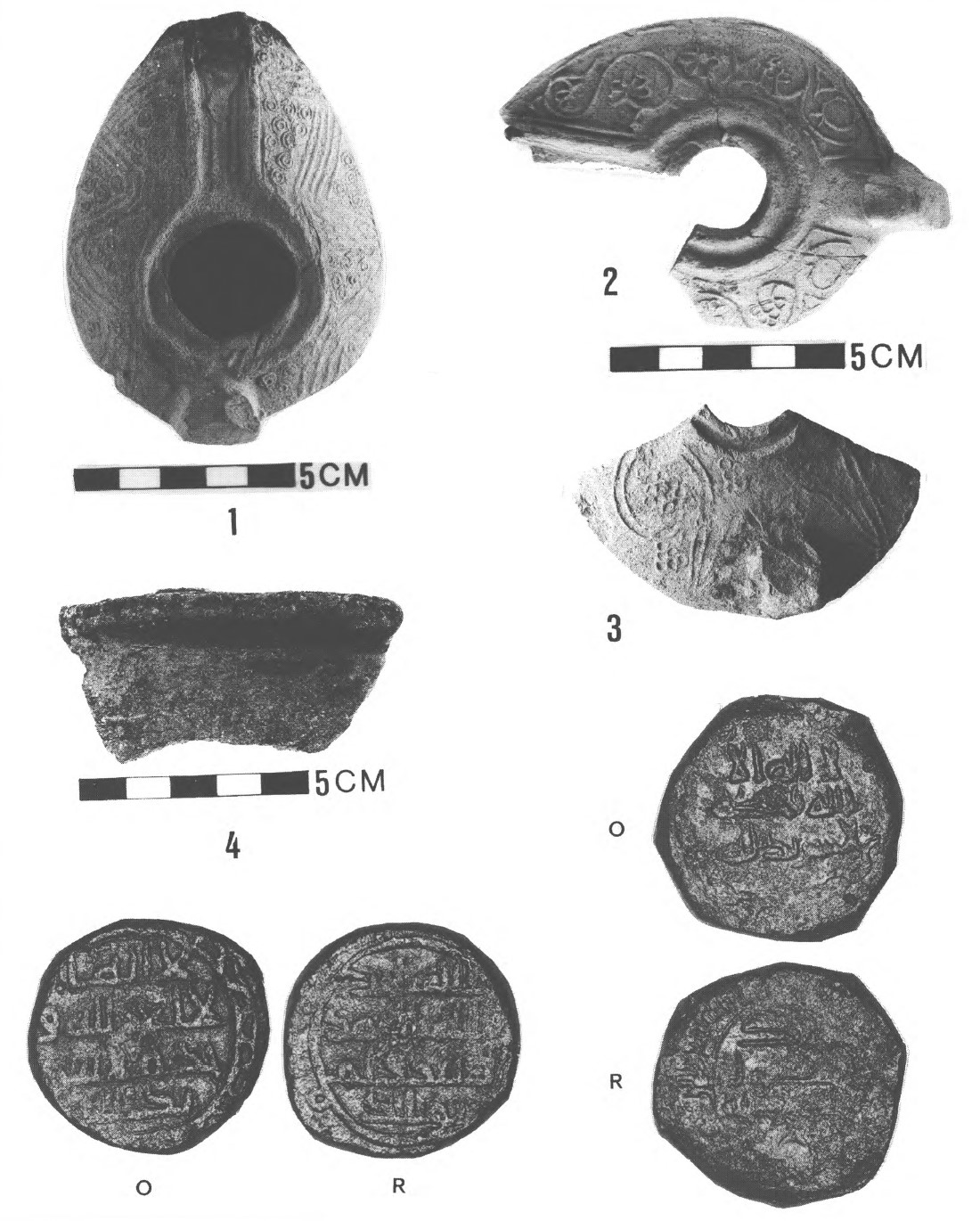
 Figure 25
Figure 25
Khirbat Yajuz, Area E.
- Complete decorated lamp
- decorated lamp fragment
- decorated lamp fragments
- sherd of a steatite cooking pot
- copper coin
- copper coin
copper coins - Reg. no. 115 and Reg. no. 108, X2, 75; nos 5-6
Khalil and Kareem (2002) - Fig. 5 - Walls, arch,
and plaster floor in squares 2, 3, and 6 of Area E from Khalil and Kareem (2002)

 Figure 5
Figure 5
Khirbat Yajuz, Area E: Walls, arch, and plaster floor in squares 2, 3, and 6, looking north.
Khalil and Kareem (2002) - Fig. 7 - Walls, reinforced
bases of arches, plaster floors, and flagstone pavement in squares 2 and 7 of Area E from Khalil and Kareem (2002)
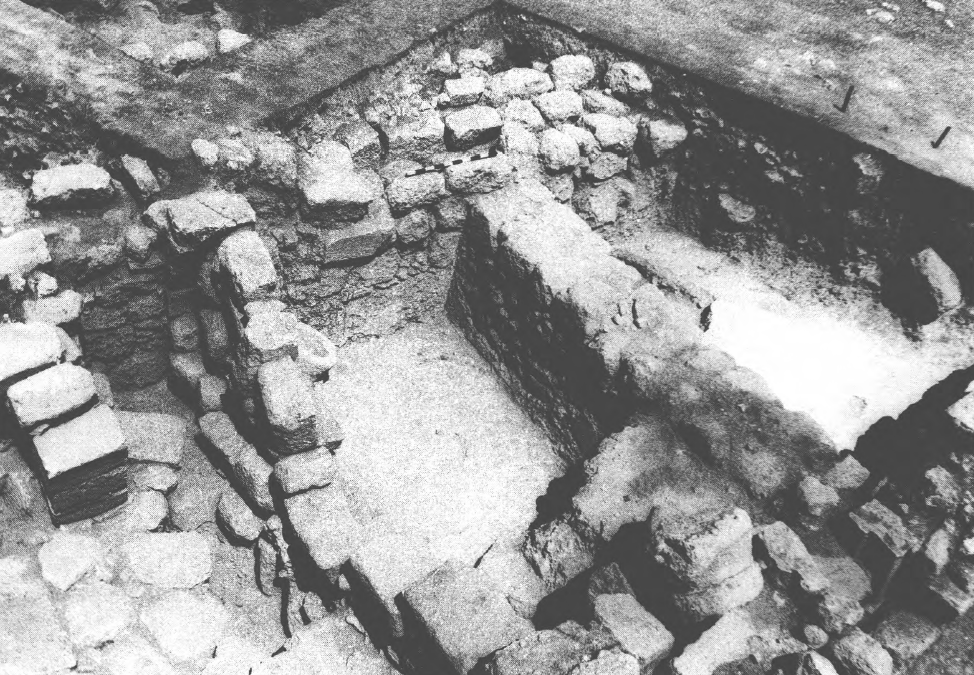
 Figure 7
Figure 7
Khirbat Yajuz, Area E: Walls, reinforced bases of arches, plaster floors, and flagstone pavement in squares 2 and 7,looking north-west.
Khalil and Kareem (2002)
| Unit | Description | Notes |
|---|---|---|
| 1 | Topsoil, ashy and greyish layers | |
| 2 | Brownish layers and stones | These layers were between 60 and 90 cm. thick and produced a very rich assortment of Abbasid pottery. |
| 3 | Architectural features | Many walls and the bases of arches were revealed within this unit. A number of reinforced arches were found in the area, but only one arch (Loc. 11 in square 3) was still in situ (Fig. 5). All the others may have required reinforcement after the earthquake of AD 749. the alignment of the two-row walls, the reinforcement of the arches, and the dividing walls, all suggest that the buildings were restored for habitation after the earthquake (Figs 4-7). |
| 4A | hawar layers and floors | Two main types of floors which were related to the walls and bases of arches were discovered. The first were compact hawar floors. |
| 4B | Plaster floors | Two main types of floors which were related to the walls and bases of arches were discovered. The second type were made of plaster floors, made of mortar |
| 5 | Flagstone pavement | Flagstone pavement was found underneath the hawar floor in square 7. Khalil and Kareem (2002) suggested that
the irregularity of the flagstone pavement was probably caused by the AD 749 earthquake. |
- Fig. 1 - Site map from
Khalil and Kareem (2002)

 Figure 1.
Figure 1.
Contour map of Khirbat Yajuz, showing the location of excavations (Areas: B, C, D and E).
Khalil and Kareem (2002) - Fig. 15 - Collapsed Arch from
Khalil (1998)

 15
15
Collapsed arch above plaster floor, looking south.
Khalil (1998) - Fig. 22 - Paved Room from
Savage et al (2001)

 Figure 22
Figure 22
Paved room at Khirbet Yajuz.
Savage et al (2001) - Fig. 25 - Early Abbasid finds from
Khalil and Kareem (2002)

 Figure 25
Figure 25
Khirbat Yajuz, Area E.
- Complete decorated lamp
- decorated lamp fragment
- decorated lamp fragments
- sherd of a steatite cooking pot
- copper coin
- copper coin
copper coins - Reg. no. 115 and Reg. no. 108, X2, 75; nos 5-6
Khalil and Kareem (2002)
Khalil (1998) excavated Khirbet Yajuz over three seasons from 1995 - 1997. In Area B, they found the remains of a small chapel. A Greek inscription found in mosaic tiles on the floor of the chapel was interpreted to date construction of the chapel to 508 CE. A destruction layer was discovered above the floor.
In the same room, above the mosaic floors, were found a ca. 15cm thick layer of ash and collapsed arches of the room. The preliminary study of the pottery sherds from this layer date to the Byzantine-Umayyad period, and perhaps the destruction of the chapel was caused by the 749 AD earthquake.In Area C, they uncovered a mill and wine press and more potential archeoseismic evidence
To the west and the south of the mill building there are two adjacent large rooms with internal arches - the southern room has eight arches - with plastered floors. The building might have been used as living quarters or for storage purposes. The arches collapsed above the plaster floor probably due to an earthquake (Fig. 15).Although Khalil (1998)'s report on Area E was brief and did not mention archeoseismic evidence, Savage et al (2001:448), perhaps informed by personal communication with Lufti Khalil, produced the following description of archeoseismic evidence in Area E:
A number of copper coins, beside complete vessels and pottery sherds, were retrieved in the mill and the wine press constructions can be dated to the Byzantine and Umayyad periods.
In area E, an earthquake that occurred in A.D. 748 is illustrated by the collapsed vaulted arches and the irregularities of the paved floor, which date to the Umayyad period. Later, the collapsed arches were reinforced and strengthened, and dividing walls were added. In addition, a layer of compact hawar was added on top of the pavement in order to make it level, and materials from previous periods were used (fig. 22). Two different types of pottery, associated with different architectural periods, were excavated at the area. Therefore, evidence suggests that the earthquake destroyed the building during the Umayyad period, and the building was later restored during the Abassid period.Khalil and Kareem (2002) dated an assemblage of pottery from Unit 2 which appears to provide a tight terminus ante quem for potential seismic destruction observed in Unit 5
The pottery assemblage described in this paper was recovered from loci dated after the major earthquake of AD 749, and covers a period most probably continuing until the beginning of the tenth century AD.In addition, two copper coins and some lamp fragments found above Unit 5 (Fig. 25) dated as early Abbasid.
... It is suggested that the pottery sherds under discussion can be dated to between the second half of the eighth century (749 AD) and the tenth century AD.
Two copper coins dated to the early Abbasid period 3 were found in Area E (Square 4, Locus 7, and Square 7, Locus 1). The lamps and their surface decoration in this assemblage are also helpful chronological indicators. Only two lamp fragments of the so-called 'Jerash type', dated between the sixth and the eighth centuries, were recorded in Area E during the last three seasons. The majority were dated to the ninth and tenth centuries AD.When the terminus ante quem of Khalil and Kareem (2002) (Abassid) is combined with the terminus post quem of Khalil (1998) (Umayyad), this seismic destruction appears to be well dated to the mid-8th century CE.
Khalil (1998) excavated Khirbet Yajuz over three
seasons from 1995–1997. In Area B, they found the remains of a small
chapel. A Greek inscription in mosaic tiles on the floor of the chapel
was interpreted to date its construction to 508 CE. A destruction layer
was discovered above the floor. Khalil (1998) writes that “in the same
room, above the mosaic floors, were found a ca. 15 cm thick layer of ash
and collapsed arches of the room.” He adds that “the preliminary study
of the pottery sherds from this layer date to the Byzantine-Umayyad
period, and perhaps the destruction of the chapel was caused by the 749
AD earthquake.”
In Area C, they uncovered a mill and wine press with additional possible
archaeoseismic evidence. Khalil (1998) notes that “to the west and the
south of the mill building there are two adjacent large rooms with
internal arches—the southern room has eight arches—with plastered
floors. The building might have been used as living quarters or for
storage purposes. The arches collapsed above the plaster floor probably
due to an earthquake (Fig. 15).” He reports that “a number of copper
coins, beside complete vessels and pottery sherds, were retrieved in
the mill and the wine press constructions” and that these “can be dated
to the Byzantine and Umayyad periods.”
Although Khalil (1998) did not report archaeoseismic
evidence from Area E, Savage et al. (2001:448), possibly informed by
personal communication with Lufti Khalil, stated that “in Area E, an
earthquake that occurred in A.D. 748 is illustrated by the collapsed
vaulted arches and the irregularities of the paved floor, which date to
the Umayyad period. Later, the collapsed arches were reinforced and
strengthened, and dividing walls were added. In addition, a layer of
compact hawar was added on
top of the pavement in order to make it level, and materials from
previous periods were used (fig. 22). Two different types of pottery,
associated with different architectural periods, were excavated at the
area. Therefore, evidence suggests that the earthquake destroyed the
building during the Umayyad period, and the building was later restored
during the Abassid period.”
Khalil and Kareem (2002) described an assemblage of
pottery from Unit 2 which appears to provide a tight
terminus ante quem for
potential seismic destruction observed in Unit 5. They wrote that “the
pottery assemblage described in this paper was recovered from loci
dated after the major earthquake of AD 749, and covers a period most
probably continuing until the beginning of the tenth century AD.” They
suggested that “the pottery sherds under discussion can be dated to
between the second half of the eighth century (749 AD) and the tenth
century AD.”
Two copper coins and some lamp fragments found above Unit 5 (Fig. 25)
were dated as early Abbasid. Khalil and Kareem (2002) noted: “Two
copper coins dated to the early Abbasid period”
[3] “were found in Area E (Square 4, Locus 7, and Square
7, Locus 1). The lamps and their surface decoration in this assemblage
are also helpful chronological indicators. Only two lamp fragments of
the so-called
'Jerash type', dated between the sixth and the eighth
centuries, were recorded in Area E during the last three seasons. The
majority were dated to the ninth and tenth centuries AD.”
When the terminus ante quem
from Khalil and Kareem (2002) is combined with the
terminus post quem from
Khalil (1998), this seismic destruction appears to
be well dated to the mid-8th century CE.
| Effect | Location | Image(s) | Description |
|---|---|---|---|
|
Area B
 Figure 1.
Figure 1.Contour map of Khirbat Yajuz, showing the location of excavations (Areas: B, C, D and E). Khalil and Kareem (2002) |
|
|
|
Area C
 Figure 1.
Figure 1.Contour map of Khirbat Yajuz, showing the location of excavations (Areas: B, C, D and E). Khalil and Kareem (2002) |
Fig. 15

 15
15Collapsed arch above plaster floor, looking south. Khalil (1998) |
|
|
Area E
 Figure 1.
Figure 1.Contour map of Khirbat Yajuz, showing the location of excavations (Areas: B, C, D and E). Khalil and Kareem (2002) 
 Figure 2
Figure 2Khirbat Yajuz, Area E: plan of the architeetural features in squares 1-14. Khalil and Kareem (2002) |
Fig. 22 - example of paved floor

 Figure 22
Figure 22Paved room at Khirbet Yajuz. Savage et al (2001) Fig. 4 
 Figure 4
Figure 4Khirbat Yajuz, Area E; isometric reconstruction of Umayyad structures in squares 2, 6, 7. and 8 Khalil and Kareem (2002) Fig. 5 
 Figure 5
Figure 5Khirbat Yajuz, Area E: Walls, arch, and plaster floor in squares 2, 3, and 6, looking north. Khalil and Kareem (2002) Fig. 6 
 Figure 6
Figure 6Khirbat Yajuz, Area E; isometric reconstruction of Abbasid structures in squares 2, 6, 7. and 8 Khalil and Kareem (2002) Fig. 7 
 Figure 7
Figure 7Khirbat Yajuz, Area E: Walls, reinforced bases of arches, plaster floors, and flagstone pavement in squares 2 and 7,looking north-west. Khalil and Kareem (2002) |
|
- Modified by JW from Fig. 2 of Khalil and Kareem (2002)
-
Earthquake Archeological Effects chart
of Rodríguez-Pascua et al (2013: 221-224)

 Earthquake Archeological Effects (EAE)
Earthquake Archeological Effects (EAE)
Rodríguez-Pascua et al (2013: 221-224)
| Effect | Location | Image(s) | Description | Intensity |
|---|---|---|---|---|
|
Area B
 Figure 1.
Figure 1.Contour map of Khirbat Yajuz, showing the location of excavations (Areas: B, C, D and E). Khalil and Kareem (2002) |
|
|
|
|
Area C
 Figure 1.
Figure 1.Contour map of Khirbat Yajuz, showing the location of excavations (Areas: B, C, D and E). Khalil and Kareem (2002) |
Fig. 15

 15
15Collapsed arch above plaster floor, looking south. Khalil (1998) |
|
|
|
Area E
 Figure 1.
Figure 1.Contour map of Khirbat Yajuz, showing the location of excavations (Areas: B, C, D and E). Khalil and Kareem (2002) 
 Figure 2
Figure 2Khirbat Yajuz, Area E: plan of the architeetural features in squares 1-14. Khalil and Kareem (2002) |
Fig. 22 - example of paved floor

 Figure 22
Figure 22Paved room at Khirbet Yajuz. Savage et al (2001) Fig. 4 
 Figure 4
Figure 4Khirbat Yajuz, Area E; isometric reconstruction of Umayyad structures in squares 2, 6, 7. and 8 Khalil and Kareem (2002) Fig. 5 
 Figure 5
Figure 5Khirbat Yajuz, Area E: Walls, arch, and plaster floor in squares 2, 3, and 6, looking north. Khalil and Kareem (2002) Fig. 6 
 Figure 6
Figure 6Khirbat Yajuz, Area E; isometric reconstruction of Abbasid structures in squares 2, 6, 7. and 8 Khalil and Kareem (2002) Fig. 7 
 Figure 7
Figure 7Khirbat Yajuz, Area E: Walls, reinforced bases of arches, plaster floors, and flagstone pavement in squares 2 and 7,looking north-west. Khalil and Kareem (2002) |
|
|
Khalil, L. (1998). "University of Jordan Excavations at Khirbat Yajuz."
Annual of the Department of Antiquities of Jordan 42.
Khalil, L. and J. Kareem (2002). "Abbasid Pottery from Area E at Khirbat Yajuz, Jordan." Levant 34(1): 111-150.
Savage, S. H., Zamora, K., & Keller, D. R. (2002). Archaeology in Jordan, 2001 Season. American Journal of Archaeology, 106(3), 435–458.

